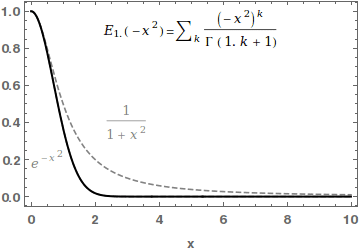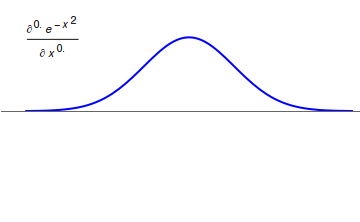|
Prabhakar Function
Prabhakar function is a certain special function in mathematics introduced by the Indian mathematician Tilak Raj Prabhakar in a paper published in 1971. The function is a three-parameter generalization of the well known two-parameter Mittag-Leffler function in mathematics. The function was originally introduced to solve certain classes of integral equations. Later the function was found to have applications in the theory of fractional calculus and also in certain areas of physics. Definition The one-parameter and two-parameter Mittag-Leffler functions are defined first. Then the definition of the three-parameter Mittag-Leffler function, the Prabhakar function, is presented. In the following definitions, \Gamma (z) is the well known gamma function defined by ::\Gamma(z)= \int_0^\infty t^e^\, dz, \quad\Re(z) > 0. In the following it will be assumed that \alpha, \beta and \gamma are all complex numbers. One-parameter Mittag-Leffler function The one-parameter Mittag-Leffler func ... [...More Info...] [...Related Items...] OR: [Wikipedia] [Google] [Baidu] |
Special Function
Special functions are particular mathematical functions that have more or less established names and notations due to their importance in mathematical analysis, functional analysis, geometry, physics, or other applications. The term is defined by consensus, and thus lacks a general formal definition, but the list of mathematical functions contains functions that are commonly accepted as special. Tables of special functions Many special functions appear as solutions of differential equations or integrals of elementary functions. Therefore, tables of integrals usually include descriptions of special functions, and tables of special functions include most important integrals; at least, the integral representation of special functions. Because symmetries of differential equations are essential to both physics and mathematics, the theory of special functions is closely related to the theory of Lie groups and Lie algebras, as well as certain topics in mathematical physics. Symbolic ... [...More Info...] [...Related Items...] OR: [Wikipedia] [Google] [Baidu] |
Tilak Raj Prabhakar
Tilak Raj Prabhakar was an Indian mathematician specializing in special functions and integral equations. In a paper published in 1971, he introduced a three-parameter extension of the Mittag-Leffler function. Subsequently, this function was to found to have numerous applications in various areas of mathematics like fractional calculus and also in certain areas of physics. The function has since been named "Prabhakar function" in honor of the person who had introduced it. Education Prabhakar secured his M.A. and B.A. degrees from the Benaras Hindu University (India) and obtained his Ph.D. from the University of Delhi (India) in 1970 with a thesis on "Integral Equations and Special Functions". Career Initially he taught at the S.D. College in Muzzaffarnagar. Then he joined the Multani Mal Modi College in Modinagar where he became Head of the Department of Mathematics and later he moved to the Ramjas College of the University of Delhi. His was an untimely demise. He was profess ... [...More Info...] [...Related Items...] OR: [Wikipedia] [Google] [Baidu] |
Mittag-Leffler Function
In mathematics, the Mittag-Leffler functions are a family of special functions. They are complex-valued functions of a complex argument ''z'', and moreover depend on one or two complex parameters. The one-parameter Mittag-Leffler function, introduced by Gösta Mittag-Leffler in 1903,Haubold,H J and Mathai,A M and Saxena,R KJ Appl Math 2011, 298628/ref> can be defined by the Maclaurin series :E_ (z) = \sum_^\infty \frac, where \Gamma(x) is the gamma function, and \alpha is a complex parameter with \operatorname\left(\alpha \right)> 0. The two-parameter Mittag-Leffler function, introduced by Wiman in 1905, is occasionally called the generalized Mittag-Leffler function. It has an additional complex parameter \beta, and may be defined by the series :E_ (z) = \sum_^\infty \frac, When \beta=1, the one-parameter function E_\alpha = E_ is recovered. In the case \alpha and \beta are real and positive, the series converges for all values of the argument z, so the Mittag-Leffler fun ... [...More Info...] [...Related Items...] OR: [Wikipedia] [Google] [Baidu] |
Integral Equation
In mathematical analysis, integral equations are equations in which an unknown function appears under an integral sign. In mathematical notation, integral equations may thus be expressed as being of the form: f(x_1,x_2,x_3,\ldots,x_n ; u(x_1,x_2,x_3,\ldots,x_n) ; I^1 (u), I^2(u), I^3(u), \ldots, I^m(u)) = 0 where I^i(u) is an integral operator acting on ''u.'' Hence, integral equations may be viewed as the analog to differential equations where instead of the equation involving derivatives, the equation contains integrals. A direct comparison can be seen with the mathematical form of the general integral equation above with the general form of a differential equation which may be expressed as follows:f(x_1,x_2,x_3,\ldots,x_n ; u(x_1,x_2,x_3,\ldots,x_n) ; D^1 (u), D^2(u), D^3(u), \ldots, D^m(u)) = 0where D^i(u) may be viewed as a differential operator of order ''i''. Due to this close connection between differential and integral equations, one can often convert between the two. ... [...More Info...] [...Related Items...] OR: [Wikipedia] [Google] [Baidu] |
Fractional Calculus
Fractional calculus is a branch of mathematical analysis that studies the several different possibilities of defining real number powers or complex number powers of the differentiation operator D D f(x) = \frac f(x)\,, and of the integration operator J The symbol J is commonly used instead of the intuitive I in order to avoid confusion with other concepts identified by similar glyphs, such as identities. J f(x) = \int_0^x f(s) \,ds\,, and developing a calculus for such operators generalizing the classical one. In this context, the term ''powers'' refers to iterative application of a linear operator D to a function that is, repeatedly composing D with itself, as in \begin D^n(f) &= (\underbrace_n)(f) \\ &= \underbrace_n (f)\cdots))). \end For example, one may ask for a meaningful interpretation of \sqrt = D^ as an analogue of the functional square root for the differentiation operator, that is, an expression for some linear operator that, when applied to any f ... [...More Info...] [...Related Items...] OR: [Wikipedia] [Google] [Baidu] |
Gamma Function
In mathematics, the gamma function (represented by Γ, capital Greek alphabet, Greek letter gamma) is the most common extension of the factorial function to complex numbers. Derived by Daniel Bernoulli, the gamma function \Gamma(z) is defined for all complex numbers z except non-positive integers, and for every positive integer z=n, \Gamma(n) = (n-1)!\,.The gamma function can be defined via a convergent improper integral for complex numbers with positive real part: \Gamma(z) = \int_0^\infty t^ e^\textt, \ \qquad \Re(z) > 0\,.The gamma function then is defined in the complex plane as the analytic continuation of this integral function: it is a meromorphic function which is holomorphic function, holomorphic except at zero and the negative integers, where it has simple Zeros and poles, poles. The gamma function has no zeros, so the reciprocal gamma function is an entire function. In fact, the gamma function corresponds to the Mellin transform of the negative exponential functi ... [...More Info...] [...Related Items...] OR: [Wikipedia] [Google] [Baidu] |
Fox–Wright Function
In mathematics, the Fox–Wright function (also known as Fox–Wright Psi function, not to be confused with Wright Omega function) is a generalisation of the generalised hypergeometric function ''p''''F''''q''(''z'') based on ideas of and : _p\Psi_q \left begin ( a_1 , A_1 ) & ( a_2 , A_2 ) & \ldots & ( a_p , A_p ) \\ ( b_1 , B_1 ) & ( b_2 , B_2 ) & \ldots & ( b_q , B_q ) \end ; z \right= \sum_^\infty \frac \, \frac . Upon changing the normalisation _p\Psi^*_q \left begin ( a_1 , A_1 ) & ( a_2 , A_2 ) & \ldots & ( a_p , A_p ) \\ ( b_1 , B_1 ) & ( b_2 , B_2 ) & \ldots & ( b_q , B_q ) \end ; z \right= \frac \sum_^\infty \frac \, \frac it becomes ''p''''F''''q''(''z'') for ''A''1...''p'' = ''B''1...''q'' = 1. The Fox–Wright function is a special case of the Fox H-function : _p\Psi_q \left begin ( a_1 , A_1 ) & ( a_2 , A_2 ) & \ldots & ( a_p , A_p ) \\ ( b_1 , B_1 ) & ( b_2 , B_2 ) & \ldots & ( b_q , B_q ) \end ; z \right= H^_ \left \begin ( 1-a_1 , A_1 ) & ( 1-a_2 , A_ ... [...More Info...] [...Related Items...] OR: [Wikipedia] [Google] [Baidu] |
Laplace Transform
In mathematics, the Laplace transform, named after Pierre-Simon Laplace (), is an integral transform that converts a Function (mathematics), function of a Real number, real Variable (mathematics), variable (usually t, in the ''time domain'') to a function of a Complex number, complex variable s (in the complex-valued frequency domain, also known as ''s''-domain, or ''s''-plane). The transform is useful for converting derivative, differentiation and integral, integration in the time domain into much easier multiplication and Division (mathematics), division in the Laplace domain (analogous to how logarithms are useful for simplifying multiplication and division into addition and subtraction). This gives the transform many applications in science and engineering, mostly as a tool for solving linear differential equations and dynamical systems by simplifying ordinary differential equations and integral equations into algebraic equation, algebraic polynomial equations, and by simplifyin ... [...More Info...] [...Related Items...] OR: [Wikipedia] [Google] [Baidu] |
Special Functions
Special functions are particular mathematical functions that have more or less established names and notations due to their importance in mathematical analysis, functional analysis, geometry, physics, or other applications. The term is defined by consensus, and thus lacks a general formal definition, but the list of mathematical functions contains functions that are commonly accepted as special. Tables of special functions Many special functions appear as solutions of differential equations or integrals of elementary functions. Therefore, tables of integrals usually include descriptions of special functions, and tables of special functions include most important integrals; at least, the integral representation of special functions. Because symmetries of differential equations are essential to both physics and mathematics, the theory of special functions is closely related to the theory of Lie groups and Lie algebras, as well as certain topics in mathematical physics. Symbolic ... [...More Info...] [...Related Items...] OR: [Wikipedia] [Google] [Baidu] |
Fractional Calculus
Fractional calculus is a branch of mathematical analysis that studies the several different possibilities of defining real number powers or complex number powers of the differentiation operator D D f(x) = \frac f(x)\,, and of the integration operator J The symbol J is commonly used instead of the intuitive I in order to avoid confusion with other concepts identified by similar glyphs, such as identities. J f(x) = \int_0^x f(s) \,ds\,, and developing a calculus for such operators generalizing the classical one. In this context, the term ''powers'' refers to iterative application of a linear operator D to a function that is, repeatedly composing D with itself, as in \begin D^n(f) &= (\underbrace_n)(f) \\ &= \underbrace_n (f)\cdots))). \end For example, one may ask for a meaningful interpretation of \sqrt = D^ as an analogue of the functional square root for the differentiation operator, that is, an expression for some linear operator that, when applied to any f ... [...More Info...] [...Related Items...] OR: [Wikipedia] [Google] [Baidu] |


